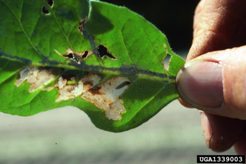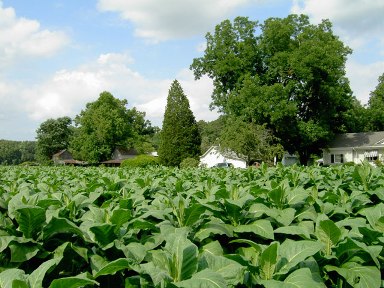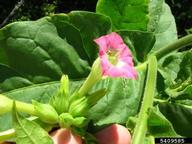
Adaptations
Nicotiana tabacum has acquired a number of interesting adaptations in order to cope with the environment around itself. Some items that may affect the plant and its production include: predators, precipitation, and temperature.
Predators
 The
tobacco plants have a unique technique on compensating for the
manifestation of the tobacco budworm. A study done at the
North Carolina State University shows that the tobacco plant resists
the damage due to tobacco budworms by increasing the weight of its
healthy leaves. Throughout the study is was observed that very
few leaves were completely consumed by the worm which is the cause
of premature topping which could result in stunted plant growth and
delayed maturity. Premature topping results in significant
loss in the crop and can destroy a harvest. Overall the
budworm did not have a huge effect on the plants and its
productivity because premature topping was not observed in this
study. If you would like to read this study done on tobacco
budworms more in depth, click
here.
The
tobacco plants have a unique technique on compensating for the
manifestation of the tobacco budworm. A study done at the
North Carolina State University shows that the tobacco plant resists
the damage due to tobacco budworms by increasing the weight of its
healthy leaves. Throughout the study is was observed that very
few leaves were completely consumed by the worm which is the cause
of premature topping which could result in stunted plant growth and
delayed maturity. Premature topping results in significant
loss in the crop and can destroy a harvest. Overall the
budworm did not have a huge effect on the plants and its
productivity because premature topping was not observed in this
study. If you would like to read this study done on tobacco
budworms more in depth, click
here.
 Precipitation
Precipitation
Nicotiana tabacum is known to be a rather drought resistant plant due to genetic engineering but it still requires a well-distributed rainfall to reach a good healthy plant. Genetic engineering has allowed the plant to better preserve and hold water in during times of drought or low rainfall, allowing for a better harvest in a wider range of habitats. Many scientists are able to form "transgenic" tobacco plants by adding or modifying a certain gene in the plants genome. One example is the addition of the TPS1 gene that is able to synthesize trehalose. This in turn increases the plants drought tolerance. Untreated tobacco plants usually undergo initial rapid water-loss and late slow water-loss phases resulting in excess water loss. The treated plants will undergo slow water loss phases only at greater weights. This is possible because their stomata will actually react earlier to mild drought stress resulting in more water retention for the plant.
Temperature
 The
effect of temperature on Nicotiana tabacum
really determines its habitat and where it will be able to grow.
Tobacco needs about 100 to 120 days of frost free weather to be able
to reach full maturity. Nicotiana tabacum can be
grown in areas that only see about 80 to 90 days of frost free
weather but they will not be able to reach full maturity and their
flowers will not be at their full potential when harvest time comes
around. This somewhat flexible habitat allows the plant to be
found as far north as Sweden and as far south as Australia.
The
effect of temperature on Nicotiana tabacum
really determines its habitat and where it will be able to grow.
Tobacco needs about 100 to 120 days of frost free weather to be able
to reach full maturity. Nicotiana tabacum can be
grown in areas that only see about 80 to 90 days of frost free
weather but they will not be able to reach full maturity and their
flowers will not be at their full potential when harvest time comes
around. This somewhat flexible habitat allows the plant to be
found as far north as Sweden and as far south as Australia.
Now that we know how tobacco adapts to its environment, lets look at the various interactions that it has with other organisms by clicking here!
Logan Van Hoof, April 2011